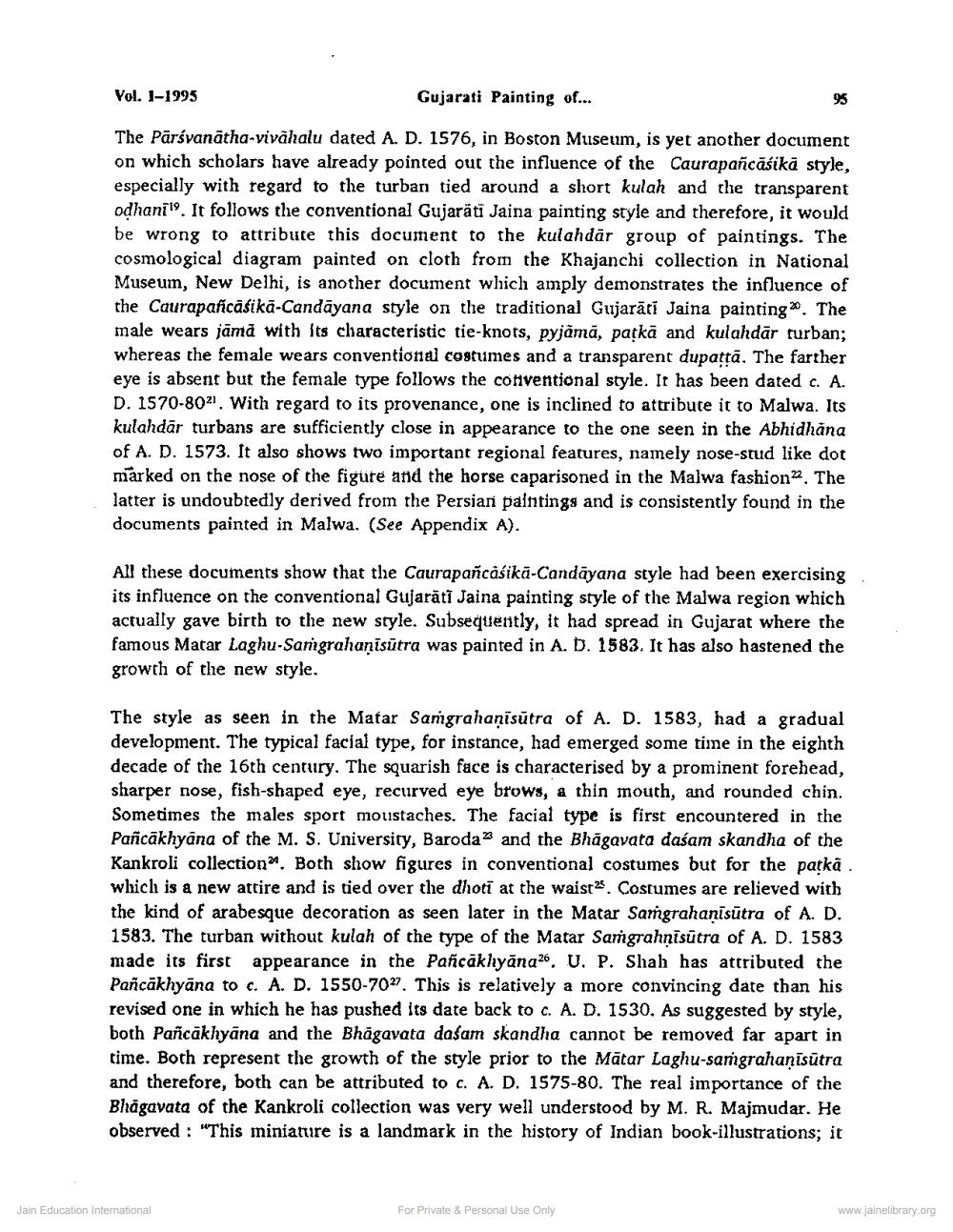Book Title: Gujarati Painting of 16th 17th Century Author(s): Lalit Kumar Publisher: Z_Nirgrantha_1_022701.pdf and Nirgrantha_2_022702.pdf and Nirgrantha_3_022703.pdf View full book textPage 4
________________ Yol. 1-1995 Gujarati Painting of... 95 The Pārsvanātha-vivāhalu dated A. D. 1576, in Boston Museum, is yet another document on which scholars have already pointed out the influence of the Caurapañcāśikā style, especially with regard to the turban tied around a short kulah and the transparent odhani". It follows the conventional Gujarati Jaina painting style and therefore, it would be wrong to attribute this document to the kulahdār group of paintings. The cosmological diagram painted on cloth from the Khajanchi collection in National Museum, New Delhi, is another document which amply demonstrates the influence of the Caurapañcāsikā-Candāyana style on the traditional Gujarati Jaina painting. The male wears jāma with its characteristic tie-knots, pyjāmā, patkā and kulahdār turban; whereas the female wears conventional costumes and a transparent dupatta. The farther eye is absent but the female type follows the conventional style. It has been dated c. A. D. 1570-8021. With regard to its provenance, one is inclined to attribute it to Malwa. Its kulahdār turbans are sufficiently close in appearance to the one seen in the Abhidhana of A. D. 1573. It also shows two important regional features, namely nose-stud like dot marked on the nose of the figure and the horse caparisoned in the Malwa fashion. The latter is undoubtedly derived from the Persian paintings and is consistently found in the documents painted in Malwa. (See Appendix A). All these documents show that the Caurapancasika-Candāyana style had been exercising its influence on the conventional Gujarātī Jaina painting style of the Malwa region which actually gave birth to the new style. Subsequently, it had spread in Gujarat where the famous Matar Laghu-Sangrahaņīsūtra was painted in A. D. 1583. It has also hastened the growth of the new style. The style as seen in the Matar Sangrahaņīsūtra of A. D. 1583, had a gradual development. The typical facial type, for instance, had emerged some time in the eighth decade of the 16th century. The squarish face is characterised by a prominent forehead, sharper nose, fish-shaped eye, recurved eye brows, a thin mouth, and rounded chin. Sometimes the males sport moustaches. The facial type is first encountered in the Pañcākhyana of the M. S. University, Baroda and the Bhāgavata daśam skandha of the Kankroli collection. Both show figures in conventional costumes but for the patka. which is a new attire and is tied over the dhotī at the waist25. Costumes are relieved with the kind of arabesque decoration as seen later in the Matar Samgrahaņīsūtra of A. D. 1583. The turban without kulah of the type of the Matar Samgrahạisutra of A. D. 1583 made its first appearance in the Pancākhyāna26. U. P. Shah has attributed the Pancākhyāna to c. A. D. 1550-7027. This is relatively a more convincing date than his revised one in which he has pushed its date back to c. A. D. 1530. As suggested by style, both Pañcākhyāna and the Bhagavata daśam skandha cannot be removed far apart in time. Both represent the growth of the style prior to the Mātar Laghu-samgrahanīsūtra and therefore, both can be attributed to c. A. D. 1575-80. The real importance of the Bhagavata of the Kankroli collection was very well understood by M. R. Majmudar. He observed : "This miniature is a landmark in the history of Indian book-illustrations; it Jain Education International For Private & Personal Use Only www.jainelibrary.orgPage Navigation
1 2 3 4 5 6 7 8 9 10 11 12 13 14 15 16 17 18
